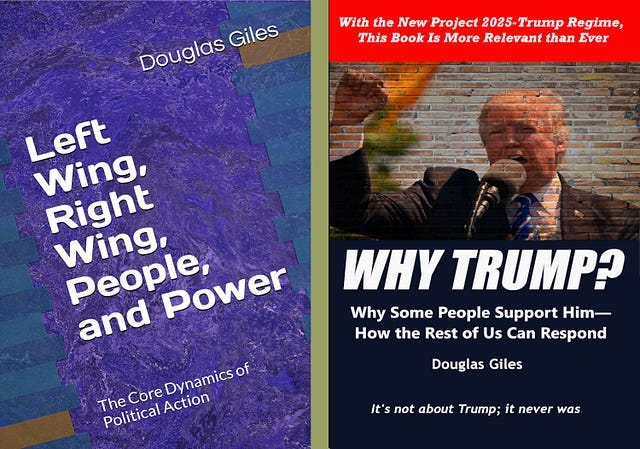I've Lowered Prices on My Books About the Right Wing
. . . because the truth needs to get out there
So, the man child had his parade, and a small percentage of the population had their protests. What next? Well, let’s talk about that. Silence is not a good option, but political action is most effective when participants are well informed and properly armed with semantic resources.
Semantic Resources
One of the best concepts I’ve encountered is that of “semantic resources.” In philosophy and sociology, semantic resources refer to tools or keys that help us understand our experiences and express ourselves. Semantic resources include learning a new perspective or way of thinking about a situation or idea. Sometimes, it’s as simple as finding the best word to describe what you are thinking and feeling. Semantic resources unlock our understanding and enhance our dialogues with others.
Education is learning facts, but more importantly, it is gathering semantic resources. It’s why we take courses; it’s why we read books. Good books give readers the keys to unlock greater understanding.
Political Books
Many, many political books are written. Some books are dry and dense, requiring much prior knowledge and effort from readers. Many books are produced as logs thrown on the bonfires of partisanship. Neither type of political book improves understanding and dialogue. A select few political books offer accessible semantic resources to people who want to better understand and engage with politics.
I have written two books that fit into that last category — to help people by offering clear, useful information and perspectives. To generate a better political environment — and by extension, build a better society — we need a clearer sense of what politics is and how people orient themselves within it. My two books offer semantic resources for readers to better understand politics and take constructive political action.
But . . . the political parties and the corporate media are busy feeding the bonfires of partisanship and aren’t interested in books that help people move past that. They’ve stonewalled me and my books. The talking heads don’t want to talk about semantic resources that would empower people. There’s more money to be made in stoking destructive anger than in catalyzing constructive dialogue.
People who have read my books have been profuse in their praise, but very few people have become aware of them. The political parties and the corporate media are probably happy to keep it that way. I am not.
I’ve lowered the prices on my two political books to sell them at cost. I put a lot of time and effort into researching and writing them, but it’s more important that they get out in the public sphere than making money. We need to be talking about the issues and semantic resources that are discussed in the books. Links to buy the books are below.
My Books Now at a Discount
What happened in the 2024 election and what has since been unleashed in 2025 is the fruition of a plan that began in the early 1970s. I’m not talking a conspiracy theory, I’m talking about power exercising power. This plan, this Project 2025, actually has its roots in the American traditions of exceptionalism and nationalism. I explain the history and what’s happening now in my books — semantic resources to help readers understand what’s going and be better able to counter it.
Avoiding petty partisan politics, I demythologize political action and conflict in Left Wing, Right Wing, People, and Power: The Core Dynamics of Political Action and Why Trump? Why Some People Support Him — How the Rest of Us Can Respond. By providing important social and historical context, the two books provide a well-reasoned, rounded view of the Project 2025-Trump regime and those who support it.
Left Wing, Right Wing, People, and Power traces the historical development of the left wing and the right wing to reveal that the core of politics is the conflict over power. Despite specific differences of time and place, political actions are consistently efforts to preserve or change the structure and dynamics of power. With this insight, we can better understand political positions and actions.
Why Trump? shows there is little new in Trump or the things he says and does. His success in attaining power lies in his ability to harness a long-simmering feeling in a segment of the American population. Realizing that simple reality opens the door to a deeper understanding of the particular strain of US political culture behind the movement that currently takes Trump as its focus.
Trump is a symptom far more than he is a cause. The right wing seeks a return to a moral purity that they imagine existed back when America was “great.” Their agenda is writ large in Project 2025 — a game plan to concentrate power in the possession of a few at the expense of everyone else.
Politics is a hostile mess, but Left Wing, Right Wing, People, and Power and Why Trump? elucidate what’s at stake in this election and what motivates people to political action. The two books clearly and concisely explain the motivations and goals of the right wing and how we can respond to the right wing and defend our free society by engaging in a constructive politics.
Left Wing, Right Wing, People, and Power: The Core Dynamics of Political Action
ISBNs: 978–1735880839 and 978–1735880846
Available in e-book and paperback
Links to Purchase the Book
Bookshop.org link (small independent book stores)
Why Trump? Why Some People Support Him — How the Rest of Us Can Respond
ISBNs: 978–1735880891 and 978–1735880853
Available in e-book, paperback, and audiobook
Links to Purchase the Book
Bookshop.org link (small independent book stores)
—





